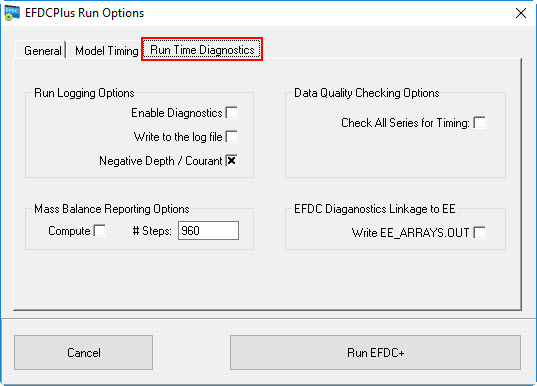Run Time Diagnostics and Mass Balance Reporting Options
Figure 1 shows the Run Logging Options frame with various check box options to aid error diagnosis. Checking the Enable Diagnostics causes EFDC to produce many extra output files but will add to runtime. The diagnostic files depend on the EFDC options, and the source code needs to be consulted to determine the content of the diagnostic files. The diagnostic files can usually be turned off after initial model testing. Other options include the ability to write Negative Depth and Courant diagnostics; and to write the optional EE_ARRAYS.OUT file, which contains data from the arrays in the EEXPOUT.FOR subroutine.
Figure 1. EFDCPlus Model Run Option Form: Run Time Diagnostics.
The Mass Balance Reporting Options frame enables mass balance checking and reporting for EFDC. The number of steps relates to the number of time steps accumulated between reporting. Consistent with the fixed naming convention, the mass balance file written by EFDC is BAL.OUT for the 3 time level solution and BAL2T.OUT for the 2 time level solution. The user must refer to the FORTRAN code to interpret these outputs.
In the Data Quality Checking Options frame, the Check All Series for Timing frame will run a check on the EFDC input files to ensure that all of the boundary condition time series files start and end times fit within the model run time, even if they are not used by a boundary condition. EFDC_Explorer ALWAYS checks for boundary condition timing for time series used by the model. However, if the user is running the model in DEBUG model (e.g. VS2010 debug mode), the model will report an out of array bounds error for any time series that starts late or ends too soon. This option helps the user either fix the error or delete the series, since it is not being used.
